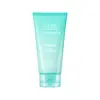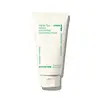What's inside
What's inside
 Key Ingredients
Key Ingredients

 Benefits
Benefits

 Concerns
Concerns

 Ingredients Side-by-side
Ingredients Side-by-side

Water
Skin ConditioningMyristic Acid
CleansingGlycerin
HumectantPotassium Hydroxide
BufferingLauric Acid
CleansingPalmitic Acid
EmollientStearic Acid
CleansingMethylpropanediol
SolventGlyceryl Stearate
EmollientLauryl Betaine
CleansingAcrylates Copolymer
Potassium Cocoyl Glycinate
Sorbitan Olivate
EmulsifyingSalicylic Acid
MaskingMelaleuca Alternifolia Leaf Oil
AntioxidantSodium Chloride
Masking1,2-Hexanediol
Skin ConditioningPolyquaternium-39
Melaleuca Alternifolia Leaf Extract
PerfumingMelaleuca Alternifolia Leaf Water
AntimicrobialPhytosteryl/Octyldodecyl Lauroyl Glutamate
Skin ConditioningPolyquaternium-7
Sodium Phytate
Butylene Glycol
HumectantMelaleuca Alternifolia Flower/Leaf/Stem Extract
Skin ConditioningEthylhexylglycerin
Skin ConditioningSodium Benzoate
MaskingHydrogenated Lecithin
EmulsifyingCentella Asiatica Extract
CleansingFicus Carica Fruit Extract
HumectantCeramide NP
Skin ConditioningTocopherol
AntioxidantNiacinamide
SmoothingAllantoin
Skin ConditioningMaltodextrin
AbsorbentDimethylsilanol Hyaluronate
HumectantHydrolyzed Sodium Hyaluronate
Skin ConditioningHydrolyzed Hyaluronic Acid
HumectantSodium Hyaluronate
HumectantPotassium Hyaluronate
Skin ConditioningHyaluronic Acid
HumectantSodium Hyaluronate Crosspolymer
HumectantHydroxypropyltrimonium Hyaluronate
Sodium Hyaluronate Dimethylsilanol
HumectantProtease
ExfoliatingSodium Acetylated Hyaluronate
HumectantSuperoxide Dismutase
AntioxidantWater, Myristic Acid, Glycerin, Potassium Hydroxide, Lauric Acid, Palmitic Acid, Stearic Acid, Methylpropanediol, Glyceryl Stearate, Lauryl Betaine, Acrylates Copolymer, Potassium Cocoyl Glycinate, Sorbitan Olivate, Salicylic Acid, Melaleuca Alternifolia Leaf Oil, Sodium Chloride, 1,2-Hexanediol, Polyquaternium-39, Melaleuca Alternifolia Leaf Extract, Melaleuca Alternifolia Leaf Water, Phytosteryl/Octyldodecyl Lauroyl Glutamate, Polyquaternium-7, Sodium Phytate, Butylene Glycol, Melaleuca Alternifolia Flower/Leaf/Stem Extract, Ethylhexylglycerin, Sodium Benzoate, Hydrogenated Lecithin, Centella Asiatica Extract, Ficus Carica Fruit Extract, Ceramide NP, Tocopherol, Niacinamide, Allantoin, Maltodextrin, Dimethylsilanol Hyaluronate, Hydrolyzed Sodium Hyaluronate, Hydrolyzed Hyaluronic Acid, Sodium Hyaluronate, Potassium Hyaluronate, Hyaluronic Acid, Sodium Hyaluronate Crosspolymer, Hydroxypropyltrimonium Hyaluronate, Sodium Hyaluronate Dimethylsilanol, Protease, Sodium Acetylated Hyaluronate, Superoxide Dismutase
Water
Skin ConditioningGlycerin
HumectantMyristic Acid
CleansingLauric Acid
CleansingPotassium Hydroxide
BufferingStearic Acid
CleansingGlyceryl Stearate
EmollientGlycol Distearate
EmollientPalmitic Acid
EmollientLauryl Hydroxysultaine
CleansingPolyquaternium-22
Lauryl Glucoside
CleansingPropanediol
SolventParfum
MaskingPotassium Cocoyl Glycinate
1,2-Hexanediol
Skin ConditioningHydrolyzed Corn Starch
HumectantPinus Densiflora Leaf Extract
AntimicrobialDisodium EDTA
Butylene Glycol
HumectantArginine
MaskingAspartic Acid
MaskingGlutamic Acid
HumectantEthylhexylglycerin
Skin ConditioningCamellia Sinensis Leaf Extract
AntimicrobialAcrylates/Stearyl Methacrylate Copolymer
Emulsion StabilisingTremella Fuciformis Sporocarp Extract
AntioxidantTetrasodium EDTA
Hyaluronic Acid
HumectantXanthan Gum
EmulsifyingCeramide NP
Skin ConditioningAcorus Calamus Root Extract
PerfumingWater, Glycerin, Myristic Acid, Lauric Acid, Potassium Hydroxide, Stearic Acid, Glyceryl Stearate, Glycol Distearate, Palmitic Acid, Lauryl Hydroxysultaine, Polyquaternium-22, Lauryl Glucoside, Propanediol, Parfum, Potassium Cocoyl Glycinate, 1,2-Hexanediol, Hydrolyzed Corn Starch, Pinus Densiflora Leaf Extract, Disodium EDTA, Butylene Glycol, Arginine, Aspartic Acid, Glutamic Acid, Ethylhexylglycerin, Camellia Sinensis Leaf Extract, Acrylates/Stearyl Methacrylate Copolymer, Tremella Fuciformis Sporocarp Extract, Tetrasodium EDTA, Hyaluronic Acid, Xanthan Gum, Ceramide NP, Acorus Calamus Root Extract
 Reviews
Reviews

Ingredients Explained
These ingredients are found in both products.
Ingredients higher up in an ingredient list are typically present in a larger amount.
1,2-Hexanediol is a synthetic liquid and another multi-functional powerhouse.
It is a:
- Humectant, drawing moisture into the skin
- Emollient, helping to soften skin
- Solvent, dispersing and stabilizing formulas
- Preservative booster, enhancing the antimicrobial activity of other preservatives
Butylene Glycol (or BG) is used within cosmetic products for a few different reasons:
Overall, Butylene Glycol is a safe and well-rounded ingredient that works well with other ingredients.
Though this ingredient works well with most skin types, some people with sensitive skin may experience a reaction such as allergic rashes, closed comedones, or itchiness.
Learn more about Butylene GlycolCeramide NP is a type of ceramide and formally known as ceramide 3.
Ceramides are intercellular lipids naturally found in our skin that bonds dead skin cells together to create a barrier. They are known for their ability to hold water and thus are a great ingredient for dry skin.
Ceramides are an important building block for our skin barrier. A stronger barrier helps the skin look more firm and hydrated. By bolstering the skin ceramides act as a barrier against irritating ingredients. This can help with inflammation as well.
If you would like to eat ceramides, sweet potatoes contain a small amount.
Read more about other common types of ceramides here:
Ceramide AP
Ceramide EOP
Ethylhexylglycerin (we can't pronounce this either) is commonly used as a preservative and skin softener. It is derived from glyceryl.
You might see Ethylhexylglycerin often paired with other preservatives such as phenoxyethanol. Ethylhexylglycerin has been found to increase the effectiveness of these other preservatives.
Glycerin is already naturally found in your skin. It helps moisturize and protect your skin.
A study from 2016 found glycerin to be more effective as a humectant than AHAs and hyaluronic acid.
As a humectant, it helps the skin stay hydrated by pulling moisture to your skin. The low molecular weight of glycerin allows it to pull moisture into the deeper layers of your skin.
Hydrated skin improves your skin barrier; Your skin barrier helps protect against irritants and bacteria.
Glycerin has also been found to have antimicrobial and antiviral properties. Due to these properties, glycerin is often used in wound and burn treatments.
In cosmetics, glycerin is usually derived from plants such as soybean or palm. However, it can also be sourced from animals, such as tallow or animal fat.
This ingredient is organic, colorless, odorless, and non-toxic.
Glycerin is the name for this ingredient in American English. British English uses Glycerol/Glycerine.
Learn more about GlycerinGlyceryl Stearate is a mix of glycerin and stearic acid.
It is used to stabilize the mixing of water and oil ingredients. By preventing these ingredients from separating, it can help elongate shelf life. It can also help thicken the product's texture.
As an emollient, it helps soften skin and supports barrier-replenishing ingredients.
In cosmetics, Glyceryl Stearate is often made from vegetable oils or synthetically produced.
This ingredient may not be fungal-acne safe
Fun fact: The human body also creates Glyceryl Stearate naturally.
Learn more about Glyceryl StearateHyaluronic acid is naturally found in healthy skin. It is a humectant, meaning it draws moisture to your skin.
This ingredient helps hydrate, soothe, and protect the skin.
What makes hyaluronic acid so hydrating? It has the capacity to bind or hold large amounts of water.
Fun fact: It is already naturally found in our bodies, such as the fluids of our eyes and our joints.
Studies find this ingredient to have anti-inflammatory and anti-microbial properties. This can help speed up wound-healing.
Hyaluronic acid can be irritating if the molecule has a low-molecular weight, or if the molecules are small.
One study found low-molecular weight hyaluronic acid to be pro-inflammatory, meaning some people may experience irritation. This is because our bodies use hyaluronic acid in the wound-healing process to signal to our bodies, via irritation, that something needs healing.
The same study found high-molecular weight hyaluronic acid to be anti-inflammatory.
These are some other common types of Hyaluronic Acid:
Learn more about Hyaluronic AcidLauric Acid is a fatty acid or lipid. About half of fatty acids in coconut oil is lauric acid.
This ingredient helps hydrate and sooth skin. As a humectant, it helps trap moisture. It also aids in cleaning and enhancing the texture of products.
Lauric acid may not be Malassezia folliculitis, or fungal acne, safe.
Learn more about Lauric AcidMyristic Acid is a saturated fatty acid. It is naturally found in milk fat. Other sources include palm oil, coconut oil, and butter fat.
Myristic Acid is an emulsifer and cleanser. As an emulsifer, it stabilizes a product by preventing ingredients from separating. Myristic Acid helps clean your skin by acting as a surfactant. It tends to gather oil and dirt on your skin to be easily rinsed away.
One study from 2021 found Myristic Acid to have anti-inflammatory properties.
Learn more about Myristic AcidPalmitic Acid is a fatty acid naturally found in our skin and in many plant and animal sources. In cosmetics, it is usually derived from palm oil. It serves many purposes in skincare, acting as a cleanser, emollient, and emulsifier.
As an emollient, palmitic acid helps soften and smooth the skin by preventing water loss. In cleansers, it helps remove oil and dirt while creating foam.
Its emulsifying properties help stabilize products by keeping water and oil-based ingredients from separating.
This may not be suitable for fungal acne-prone skin, as fatty acids like this can sometimes trigger breakouts in sensitive individuals.
Learn more about Palmitic AcidPotassium Cocoyl Glycinate is an amino acid-based surfactant and cleaning agent. This ingredient can be derived from animals or plants. It may also be synthetically created from fatty acids of the coconut and glycine.
Potassium Cocoyl Glycinate is a gentle surfactant. Surfactants help gather the dirt, oil, and other pollutants from your skin to be rinsed away. It is a mild cleanser and naturally produces foam.
Potassium hydroxide is commonly known as caustic potash. It is used to fix the pH of a product or as a cleaning agent in soap. In cleansers, it is used for the saponification of oils.
Sapnification is the process of creating fatty acid metal salts from triglycerides and a strong base. During this process, Potassium Hydroxide is used up and is not present in the final product.
Using high concentrations of Potassium Hydroxide have shown to irritate the skin.
Learn more about Potassium HydroxideStearic Acid is a fatty acid. It is an emollient, emulsifier, and texture enhancer.
As an emollient, stearic acid helps soften skin. It aids the skin's protective barrier by preventing water loss. It also provides a gentle cleansing effect without stripping away natural oils.
Stearic acid may also be used to enhance the texture of products. It can add volume and stabilize ingredients such as water and oil. This can help water and oil ingredients from separating.
Sources of stearic acid include animal or vegetable fats/oils such as coconut or shea. It can be naturally found in butter, cocoa butter, shea butter, vegetable fats, and animal tallow.
This ingredient may not be Malassezia folliculitis, or fungal-acne safe.
Learn more about Stearic AcidWater. It's the most common cosmetic ingredient of all. You'll usually see it at the top of ingredient lists, meaning that it makes up the largest part of the product.
So why is it so popular? Water most often acts as a solvent - this means that it helps dissolve other ingredients into the formulation.
You'll also recognize water as that liquid we all need to stay alive. If you see this, drink a glass of water. Stay hydrated!
Learn more about Water